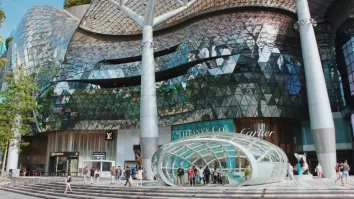
Urban Revivo opens biggest branch in Bangkok
The Chinese fast fashion retailer’s 3,000-square meter store targets consumers aged 18 to 35.
Urban Revivo (UR) has opened its largest overseas store in Bangkok, as part of its global expansion that will also include New York and London.
“Chinese companies often focus on achieving significant scale domestically before expanding overseas, which is a valid strategy,” Leo Li, chairman and CEO at parent company FMG, told reporters at the launch in the Thai capital in December. “But if you look at brands in the US, many are global from day one.”
Urban Revivo’s newest branch spans 3,000 square meters across two floors and targets young consumers aged 18 to 35. It has a striking gold-leaf facade, LED screens, and an orchid-inspired art installation made with recycled materials.
“Our focus is to celebrate contrasts and find balance,” Li said. “The Urban Revivo store combines industrial and urban materials like stainless steel with earthy tones, creating a dialogue between nature and modernity.”
FMG simultaneously launched the first overseas branch of its casual wear brand Ben Lai nearby. The store spans 1.286 square meters.
“When people wear our clothes, the most important thing is that they feel comfortable,” Li said. “For Ben Lai, it’s about doing one thing well — delivering quality.”
Both stores are in One Bangkok, a central shopping hub known for its modern architecture. The mall’s premium status aligns with FMG’s strategy to attract domestic and international shoppers.
“Thailand’s culture and lifestyle are similar to China’s, making it a natural fit for expansion,” Li said.
FMG, founded in 2006 in Guangzhou, China, is building a broad fashion portfolio. Urban Revivo’s more than 400 stores in Asia and its growing online presence in Europe and North America reflect its success in high-quality, fashion-forward apparel. Meanwhile, Ben Lai aims to expand further into Hong Kong and Southeast Asia, with plans for five to 10 new stores.
Urban Revivo is set to open stores in Europe and the Americas, with plans to set up a flagship store in New York by March 2025. Li cited the need to localize in these new markets. “We adapt designs to fit regional preferences, from body types to climate conditions. This flexibility is key to succeeding globally.”
To support this expansion, FMG is developing a global supply chain and assembling a Europe-based design team. “Our vision is to become a globalized brand, not just a regional one,” he added.
While FMG’s business model is similar to that of fast-fashion giants Zara and H&M, Li said their products are “more fashion-forward and brave. “We target the younger generation, offering designs that resonate with their bold, individualistic style.”
He added that just as LV and Chanel have their unique appeal, FMG brands focus on individuality. “Fashion is very unique — it’s not about one brand meeting all consumer needs, but about having a clear identity and message.”
At the heart of FMG’s operations is a commitment to sustainability and art.
“We use art to highlight life’s beauty while addressing environmental and social values,” Li said. “Our goal is to connect fashion, art, and sustainability in a way that resonates with customers.”
This commitment extends to the company’s environmental, social and governance (ESG) initiatives, which include using recycled materials in products and store designs. “When customers see a piece of waste fabric from production reused in an art installation, they feel the connection between fashion, art, and their daily lives,” Li said.
“We must prepare ourselves, integrate into local markets, and evolve with consumer feedback. This is how we will succeed globally.”

















 Advertise
Advertise







